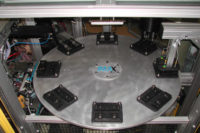Rechargeable batteries are used in everything from consumer electronics and medical devices to power tools and electric vehicles. But, the ubiquitous devices can be a pain to constantly charge.
Engineers at Montreal’s McGill University are working on a solution. They’re in the process of developing technology that could make battery chargers obsolete someday. Their goal is to build the world’s first 100 percent self-charging lithium-ion battery.
“Lithium-ion batteries have allowed the rapid proliferation of all kinds of mobile devices such as phones, tablets and computers,” says George Demopoulos, a professor of mining and materials engineering at McGill. “These tools, however, require frequent recharging because of the limited energy density of their batteries.
“With smartphones now, you can basically carry your whole office in that device; they are loaded with all sorts of applications so you need a lot of power to use it every day,” adds Demopoulos. “But, sometimes, you don’t have access to a plug to recharge.”
Demopoulos and his colleagues have been working with engineers at Hydro-Quebec to develop a solution. They believe the answer lies within the sun: solar power.
For the past 10 years, Demopoulos has been experimenting with dye-sensitized solar cells. The technology works similar to the photosynthesis of a green leaf. Based on a semiconductor formed between a photo-sensitized anode and an electrolyte, the cell can transform light into electrical energy.
“This type of solar cell is similar, from an electrochemical point of view, to a lithium battery,” says Demopoulos. “Three years ago, we took some battery ingredients from the solar cells and mixed them to make a battery electrode. After some exposure to light in the lab, we started to see small amounts of electricity being generated and stored.”
The research project is still in the early stages of development. Engineers at McGill and Hydro-Quebec’s research institute, which is active in cutting-edge battery R&D projects, are currently in the process of developing a prototype device that will be capable of harvesting and storing energy using light.
“We envision these light-charged batteries being about the same size as lithium-ion batteries currently used in portable electronic devices,” says Demopoulos. “The first applications will be for laptops and smartphones. But, it will be at least five years before something is commercially available.
“Light-charged batteries are difficult to miniaturize due to their complex circuitry and packaging issues,” Demopoulos points out. “We still need to balance all the components to ensure good light absorption, energy storage and electrical generation.”
Demopoulos and his colleagues have to build an anode (the storage component), which will close the device’s circuit, allowing energy produced by the cathode to be transferred and stored.
“We have already done half of the job,” says Demopoulos. “We know that we can design an electrode that absorbs light.
“Theoretically speaking, our goal is to develop a new hybrid solar-battery system,” adds Demopoulos. “Depending on the power it can generate when we miniaturize it, we can imagine numerous applications for self-charging batteries. This passive form of charging could play an important role in portable devices of the future.”
Someday, Demopoulos believes the frustrating experience of being stuck without a phone after forgetting to recharge it will become a thing of the past.
While the current research is focusing on small batteries, there is potential to create larger devices for other applications, such as energy storage or power backup units.



